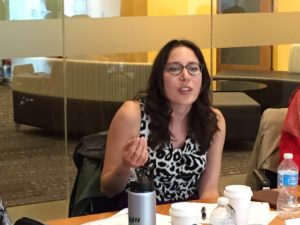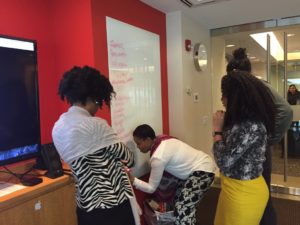Five Lessons on Social Entrepreneurship
 By Christine Lynch, 2014 ProInspire Fellow
By Christine Lynch, 2014 ProInspire Fellow
In the social sector, social entrepreneurship is a buzz word that has gained in popularity. According to Ashoka, social entrepreneurs are individuals with innovative solutions to society’s most pressing social problems. They are ambitious and persistent, tackling major social issues and offering new ideas for wide-scale change.
During the April ProInspire Fellows training in Washington DC, we focused on understanding social entrepreneurship and human centered design. Ashlee Lawson, a 2013 ProInspire Fellow, led the session. She introduced human centered design, which is a process for understanding the needs and motivations of people to develop innovative solutions. Following her introductory presentation, the Fellows broke up into teams and used the human design process that IDEO created in conjunction with Acumen. This was a great opportunity to use our own life experiences and ideas and apply them to the concept of social entrepreneurship. Our Fellows presented some creative concepts, such as:
- Creating a 2 year leadership development program for underrepresented minority students exposing them to social enterprise and impact careers in order to increase leaders of color in the social impact space
- Finding creative ways to recycle and sell used furniture while in turn benefitting previously homeless families
Last week I also connected with people from the Halcyon Incubator at a work event. They are an organization that funds social entrepreneurs through a fellowship. I was fortunate to speak with one of their program managers. He, with excitement and a passion for creating social impact, shared some of the learnings and successes of past fellows and previous ideas. I heard real life stories of people who were following the social entrepreneurship approaches discussed in our fellowship training.
Based on these discussions, I have discovered some key takeaways related to social entrepreneurship.
- Focus on the people with the problem rather than the problem itself: This is a key concept of human centered design. One example can be found in “Design Thinking for Innovation”, where authors Tim Brown and Jocelyn Wyatt explain the identified need for clean water in Hyderabad, India. The solution was to build a water tank where people could access five gallons of water a day. While the water tank appeared to solve the water problem, no one came to collect water. It turns out, individuals could not carry the required five gallons of water at one time or afford to buy in the preset quantities. The designer had failed to incorporate physical and economic limitations of those with the problem they were trying to address.
-
Get to know your user: As part of focusing on the user, make sure you really get to know them. You will get the best feedback and new ideas from people who will benefit from using your product. Develop a relationship, understand cultural differences, and identify unpredicted issues. Work with them throughout the entire process. In our training group discussion about connecting homeless families with recycled furniture, we asked “Will families really benefit from a table, or is bedding a more serious need”? These are questions you can answer only by knowing the end user, as that will help you determine if you are effectively identifying the needs and opportunities.
- Do not be afraid of failure: It is very rare that the first idea is a successful idea. Each time you go through the process, as we did with Ashlee, it will make you better prepared for the next time around and provide experience moving forward. Blake Mycoskie from TOMs had multiple endeavors before he was successful with the company and brand that thrives today.
- Be open minded and resourceful: The Program Manager from Halcyon Incubator shared an idea a fellow had regarding using mosquito nets in Africa as a way to help address a non-mosquito related problem. Not only was this low cost, mosquito nets were easy to access, allowing for a more sustainable product long term. By using the resources already available, you do not have to redevelop the wheel. By keeping an open mind, some creative solutions may literally be in front of your face.
- Be passionate: Passion sells, passion solves problems, and passion is what ultimately gets your project funded and supported. People get excited around other people who are excited, and those passionate individuals are the ones who can sustain the effort needed to implement large-scale social change.
Anyone can have an idea, but having an idea that can change the world is truly incredible. Social entrepreneurs do not see world problems, they see opportunities and bring their ideas to fruition.
Christine Lynch is a 2014 ProInspire Fellow who is currently using her passion for problem solving and project management to help serve low income youth and families with her Program Associate position at Venture Philanthropy Partners.



